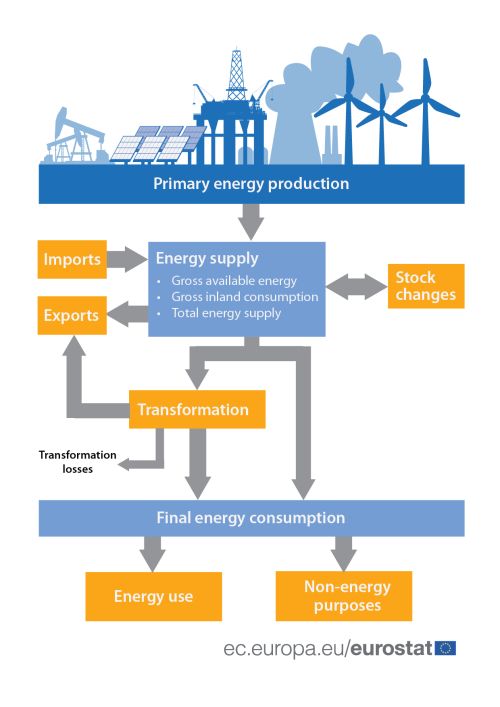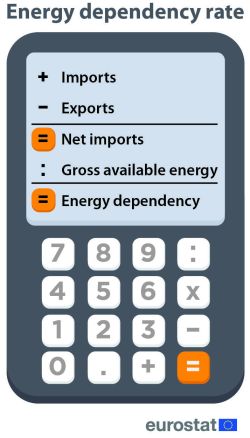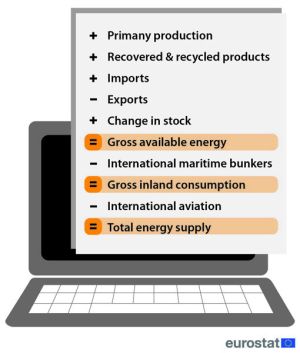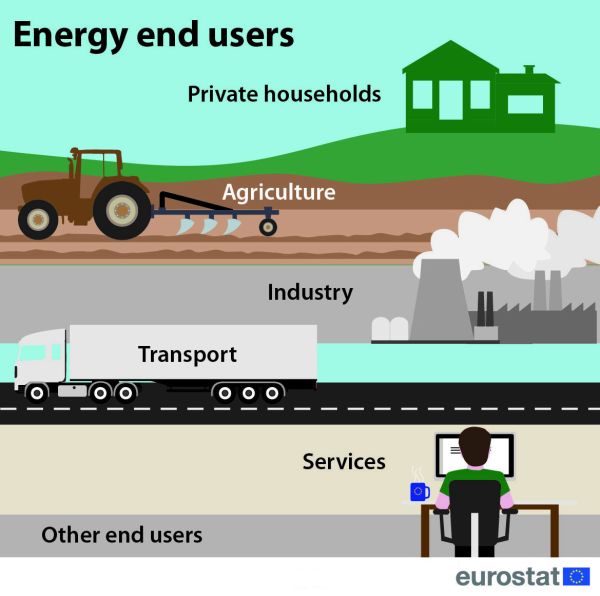Beginners:Energy flows
Highlights
This article is part of Statistics 4 beginners, a section in Statistics Explained where indicators and concepts are described in a simple way to make the world of statistics a bit easier to understand.
Energy statistics help us to understand and analyse the complex process of energy in our society. This article presents the key elements of EU energy statistics, while the article Energy – background describes how energy statistics can be used, key energy policies, questions that can be answered through energy statistics, how energy statistics are collected and which tools are available to make it easier to understand energy statistics.
Full article
Energy flow: from production to consumption
Energy commodities can be extracted or captured directly from natural resources (primary energy sources), for example in coal mines, crude oil fields, nuclear heat, hydro power plants, or in the fabrication of biofuels derived from biomass. Primary energy sources can be divided into fossil fuels, nuclear and renewable energy from water, wind, sunlight, biomass, etc.
When a country’s energy production (primary production) is not sufficient to meet its energy demand (gross available energy), part of the energy needs to be imported from third countries or taken from stocks (energy quantities that can be stored for a certain period of time and be withdrawn afterwards). Therefore, to provide a proper overview over the total energy available in the EU, energy production should always be put in context with imports and stock changes.
Once they become available, mainly through production or imports, energy products can be directly consumed (e.g. gas that is burnt for heating in a household boiler) or can go through a transformation process to be transformed into a different energy product (e.g. crude oil into motor gasoline in a refinery, or gas into electricity in a power plant) and then either be exported (sold to another country) or consumed (e.g. electricity used in a hospital).
The different steps in the energy flow can be found in more detail below:
Primary and secondary energy products
Primary energy production is any extraction of energy products, in a useable form, from natural sources.
The production of energy in the EU is spread across a range of different energy sources: solid fuels, natural gas, crude oil, nuclear energy and renewable energy. In 2021, for instance, renewable energy was the largest contributing source to primary energy production in the EU (41 % of total EU energy production). Renewable energy sources, also called renewables, are energy sources that replenish (or renew) themselves naturally. They include wind power, solar power (thermal, photovoltaic and concentrated), hydro power, tidal power, geothermal energy, ambient heat captured by heat pumps, biofuels and the renewable part of municipal waste.
Nuclear energy (31 %) was the second largest source produced in the EU, followed by solid fuels (18 %), natural gas (6 %) and crude oil (3 %).
Energy products which are not primary, but produced by transforming primary energy sources, are called derived products or ‘secondary products’. Secondary energy comes from the transformation of primary energy (or from further transformation of secondary energy).
The generation of electricity by burning fuel oil is an example: fuel oil is a secondary product produced from the primary product crude oil, while electricity is also a secondary product (as it is produced from another primary or in this case secondary product). Other examples include petroleum products (secondary) from crude oil (primary), coke-oven coke (secondary) from coking coal (primary), charcoal (secondary) from fuelwood (primary), etc.
Both electricity and heat can be produced as primary or secondary products. For instance, primary electricity is produced directly from the power of waterfalls in hydro power plants, while secondary electricity can be generated, e.g., by burning fossil fuels. Primary heat is captured from natural sources (such as through solar panels, or from geothermal reservoirs underground), while secondary heat is produced from burning combustible fuels (such as heat produced in a combined heat and power plant burning gas).
When energy is transformed from one form to another, for example when generating electricity or heat in thermal power plants (where primary energy sources are burned), some of the energy is lost in the process. This is called transformation losses.
Imports of energy
The energy available in the EU comes from energy produced in the EU and from imports of energy from outside the EU. For example, in 2021, the EU produced around 44 % of its own energy and imported 56 %.
It is important that the origins and destinations of trade in energy commodities are recorded, in order to analyse a country’s dependency on imports of energy from other countries (the energy dependency rate). However, for energy commodities such as electricity and natural gas that are transported through networks, origin and destination are more difficult to determine. This is because electrons (in the case of electricity) and gas molecules (in the case of natural gas) from different origins cannot be distinguished as soon as they are mixed in the network grid.
The energy dependency rate shows the extent to which an economy relies upon imports in order to meet its energy needs. The energy dependency rate is defined as the net energy imports [imported quantities of energy commodities minus the corresponding exports) divided by gross available energy. A negative dependency rate indicates that the country is a net energy exporter. A dependency rate higher than 100 % means that more energy products have been imported than were needed in the time period, meaning that the excess energy products have been stocked.
Energy supply: Gross available energy, Gross inland consumption and Total energy supply
There are different ways to measure how much energy is available for consumption, depending on what is included. The energy that is available for consumption in a country, either produced and/or imported (after deducting exports and taking account of stock changes) is called Gross available energy and includes different energy sources.
Gross available energy represents the quantity of energy that is necessary to satisfy all energy demand in a country. It includes: • the energy needed for energy transformation; • support operations of the energy sector itself, as well as transmission and distribution losses; • the energy needed for end-users (final energy consumption), meaning citizens, industry, transport, etc.; • fossil fuels used as raw materials (‘for non-energy purposes’), for example in the chemicals industry; • any energy products procured by a country but used elsewhere, for example kerosene for international air transport and bunkers for international maritime transport.
Gross inland energy consumption (‘gross inland consumption’) is the overall supply of energy for all activities in a country. It includes the points above which are included in ‘Gross available energy’. However, the big difference is that it excludes international maritime bunkers, but includes kerosene for international air transport.
Total energy supply means the overall supply of energy for all activities on the territory of the country, however excluding both international aviation and maritime bunkers.
One of the reasons why it is essential to define these different flows, which either include and/or exclude international marine bunkers and international aviation, is related to how the emissions from international marine bunkers and international civil aviation are reported to the United Nations Framework Convention on Climate Change (UNFCCC) in national inventories: in fact, these emissions are excluded from the national inventories.
Final consumption
The final consumption of fuels covers their use for energy (heat-raising) and for non-energy purposes (such as the use of natural gas as a feedstock to produce chemicals, the use of bitumen in roads or the use of oils as lubricants). Fuels used for the production of electricity and heat for sale, as well as the quantities of the energy produced, are excluded from final consumption as they are already accounted for under ‘transformation’.
Of the total energy available in the EU, only a part - around two thirds - reaches end users as final energy consumption (energy use). These end users include for example EU citizens, industry and transport. The difference - around one third - is mainly lost either during electricity generation and distribution, or is used to support energy production processes (energy sector), and in final non-energy consumption (non-energy uses). Final energy consumption is the total energy consumed by end users, in other words the energy that reaches the final consumer's door.
The main energy end user categories are:
- Private households
- Agriculture
- Industry
- Transport
- Services
- Other end users
As indicated above, final energy consumption does not include e.g. the energy used by the energy sector itself. The ‘energy sector’ refers to the consumption of the energy industry to support extraction (mining, oil and gas production) or plant operations related to transformation activities (for example, the pre-heating of the oven in the coke oven plants).
Energy balances and energy flow diagrams
Do you want to find out more about the different flows described above? Then you should look at the energy balance which presents all energy products of a country and production, transformation and consumption of these energy products by different types of economic actors (industry, transport, etc.). It represents the most complete statistical account of energy products and their flow in the economy.
Energy balances can be graphically represented through flow diagrams (also called Sankey diagrams), which allow users to visualise the energy flow in an illustrative and intuitive way. These energy flows can be combined, split and traced through a series of events or processing stages.
Eurostat’s Sankey energy tool is based on a series of nodes (marked in black) connected by flows. These nodes represent events or processes (such as imports, final energy consumption, etc.). The flows (in different colours) represent the different energy products. The width of each stream in the flow represents the amount of energy (fuel).
Direct access to
Related articles:
- All Statistics Explained articles concerning energy statistics, in particular Energy statistics - an overview
- Statistics 4 beginners
Glossary items in Statistics Explained:
Main glossary of energy statistics terms
- Total energy supply
- Primary production of energy
- Energy dependency rate
- Primary energy consumption
- Final energy consumption
- Energy intensity
- Gross electricity generation
- Gross national electricity consumption
- Renewable energy sources
- Fossil fuels
- Petroleum products
- Crude oil
- Biofuels
- Tonnes of oil equivalent (toe)
- Kilowatt hours (KWh)




